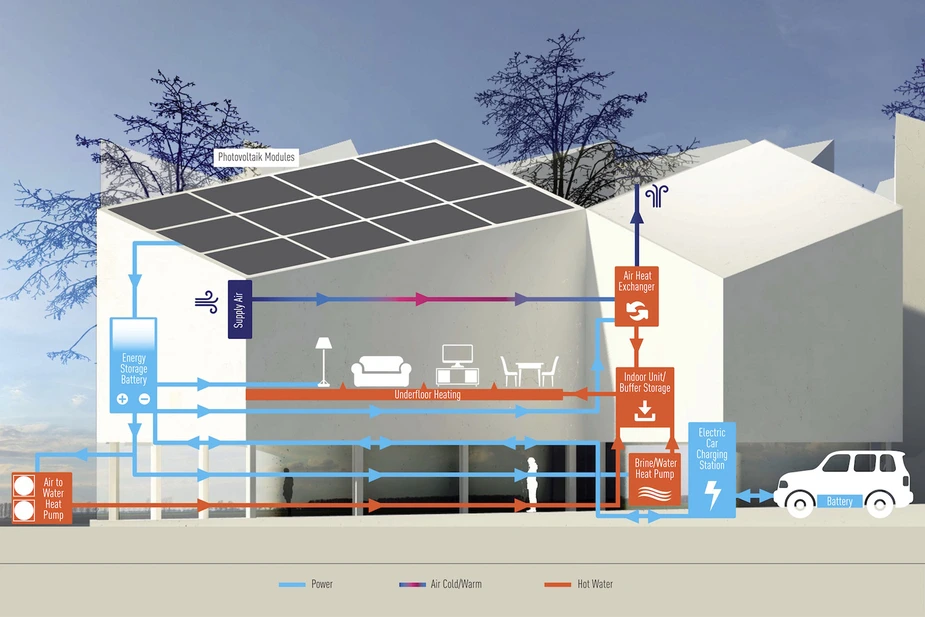Efficient and convenient
Energy-efficient living in so-called Plus-Energy-Houses and so-called “Powerhouses”
Many single-family houses are now increasingly built as passive or plus-energy houses. Several Adlershof-based projects aim to show that multi-family residential homes can also combine high energy efficiency with a pleasant living environment at moderate costs.
A house that produces more electricity and heat than its residents consume – while this sounds like Utopia, it is becoming a reality on Newtonstraße in Adlershof: the first tenants will move into the “Powerhouse” in early-2018. Consisting of five detached houses and 128 apartments for rent, this group of new buildings is built according to the plus-energy house standard, which is still very uncommon for multi-family homes in Germany. Stefanie Frensch says the project is “a model for sustainable residential construction”. She is chief executive of HOWOGE, the city-owned housing company, which acquired the “Powerhouse” from the project developer Laborgh Investment GmbH. “We aimed at proving that utmost energy efficiency standards are no luxury in residential construction,” says Florian Lanz, managing director of Laborgh.
The HOWOGE calculates a basic rent of ten euro per square meter. What is more, residents can look forward to the utilities amounting to no more than 0,40 euro per square metre per month, which is half as much as in an average apartment for rent. This high energy efficiency is gained by a bundle of measures. First, the buildings planned by the architecture firm Deimel Oelschläger have good thermal insulation and a highly-efficient air conditioning system that uses heat recovery. Secondly, solar thermal systems and photovoltaic systems on the roof produce heat and electricity. Unused heat is fed back into the district heating system of the BTB, the local district heating provider, which makes expensive heat storage obsolete.
The adjacent Newton project is also quite ambitious in terms of energy use. The building cooperative was initiated by three architecture firms and consists of three houses with 39 condos, which are currently in construction phase. They are designed as Plus-Energy-Houses, which combine passive house design (highly insulated exterior walls, thermal insulation glazing, air conditioning with waste heat recovery) with solar-based, local production of electricity and heat.
Construction on Future Living Berlin, another remarkable project located on Groß-Berliner Damm, will commence in the third quarter this year. A multitude of smart home applications will be used in this ensemble that consists of 69 apartments for rent, 19 short-term rentals and a 600-square-metre exhibition space. The project is developed by the Berlin-based development company Unternehmensgruppe Krebs; the builder-owner is GSW Sigmaringen, a housing company that belongs to the non-profit organisation Sozialverband VdK Deutschland. The energy concept rests on a mix of photovoltaics, thermal pumps, and battery storage that works with technology provided by the electronic corporation Panasonic.
“With Future Living Berlin, we want to gather experiences how the residents use the technical opportunities,” says Birgid Eberhardt, head of the Smart Home Department at the GSW Sigmaringen. This is also an important question regarding other projects in Adlershof. Many energy-saving projects have shown that the energy saved was lower than expected because the residents did not heat and air their apartments the way it was required. But, regarding the powerhouse, the planners are quite relaxed. No, they are not planning a training programme for future residents, says HOWOGE speaker Sabine Pentrop. “People that are already airing their flats properly – by not merely tilting the windows, but fully opening them - will continue to do so in the Powerhouse.”
By Christian Hunziker for Adlershof Journal
